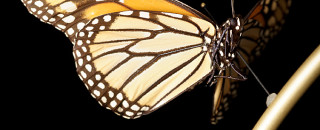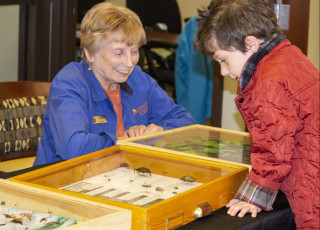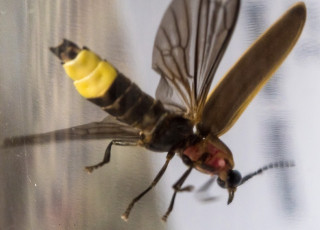Traveling Treasures Highlights Amazing Migration Stories
Salmon return from the ocean to the streams where they hatched. Monarch butterflies roost by the millions in oyamel trees. Caribou surge over the tundra. Migrations are magnificent and mysterious, a great rhythm of movement across the landscape. The Natural History Museum of Utah’s Traveling Treasures program unveils a new exhibit for 2012, Amazing Migration, featuring specimens and objects from the Museum’s collections that offer a glimpse of the swirl of animals and even plants in migratory motion across the globe.
Traveling Treasures is sponsored by the Natural History Museum of Utah at the University of Utah and Zions Bank and is in its 15th year of the partnership. The exhibit, which changes its theme every two years, is installed in the lobbies of Zions Bank in communities across the state of Utah. During the span of the program, it has visited 166 communities, traveled approximately 20,800 miles, and reached more than 400,000 Utah residents through the exhibit and related free family events.
Certain exhibitions also entail a free family event for members in the community. The free events feature dozens of hands-on, science-based activities such as: panning for rocks, minerals, and $1 coins; making fossil trilobites and ammonites; examining rocks and minerals with microscopes; and learning about the Great Salt Lake - to name just a few of the hands-on activities.
“As the state Museum of natural history, we want to reach out to communities across the entire state of Utah to extend the opportunity for residents to experience the Museum’s vast collections,” said Museum Executive Director Sarah George. “The Traveling Treasures exhibit has been an important exhibit that has helped relay the story of the Museum’s collections across the state. Amazing Migrations is one of those stories, and it shows how Utah is connected to places all over the globe.”
The new exhibit details migrations of people, animals and even plants, displaying: a cadre of Monarch butterflies; a majestic deer skull; and even an ancient moccasin worn out by its drifting owner, to name a few of the dozens of objects and specimens displayed. Amazing Migration will be in the lobby of 11 different Zions Banks during the 2012 calendar year.
In all, the Traveling Treasures exhibit, Amazing Migration, will travel 1,280 miles across the state of Utah, visiting 11 communities in 2012. After debuting in Brigham City in February, the exhibit will be displayed in: South Ogden, Tooele, Saratoga Springs, Richfield, Salina, Manti, Price, Moab, Monticello and Kanab this year.
Migrations are amazing. Scientists know why animals migrate, but much less about how they make their journeys. But, migrations also create connections. Through migrating animals, Utah is connected to the Arctic, South America, and countless places in between.
The Natural History Museum of Utah, the University of Utah, is one of the leading scientific research and cultural institutions in the Intermountain West. Established in 1963, the Museum cares for over 1.2 million objects and offers innovative exhibitions and educational programs to thousands of residents and visitors each year, including traveling and permanent exhibits, special events and other programs. The Museum also offers a variety of outreach programs to communities and schools throughout Utah, reaching every school district in the state annually. The Museum has an active research program with more than 30 scientists and 10 field expeditions each year.
2012 Traveling Treasures Destinations
- February - Brigham City, 98 North Main Street (Free Family Event)
- March - South Ogden, 5635 South Harrison Boulevard (Display Only)
- April - Tooele, 998 North Main (Display Only)
- May - Saratoga Springs, 1533 North Redwood Road (Free Family Event)
- June - Richfield, 55 West 100 North (Free Family Event)
- July - Salina, 155 West Main (Display Only)
- August - Manti, 1 South Main Street (Free Family Event)
- September - Price, 45 South Carbon Avenue (Free Family Event)
- October - Moab, 330 South Main Street (Free Lecture)
- November - Monticello, 233 East Center Street (Display Only)
- December - Kanab, 41 East Center Street (Display Only)
Amazing Migrations Objects and Specimens
- Pinyon pine voucher
- Pinyon pine cones
- Pinyon pine nuts
- Bone awls
- Shell beads
- Pitched Navajo jug
- Apache Basket
- Ancient Moccassin
- Doliconyx orizivorus (Black bird)
- Leucosticte tephrocotic (Gray-crowned Rosy Finch)
- Sialia currucoides (Mountain Blue bird)
- Vermivora virginiae (Virginia's Warbler)
- Puffinus griseus (Sooty Shearwater)
- Puma Concolr skull (Mountain lion)
- Lasionycteris noctivagans (Silver-haired bat)
- Lasiurus cinereus (Hoary bat)
- Pygmy Owl (Glaucidium gnoma pinicola)
- Mule Deer skull (Odocoileus hemionus)
- Monarch butterflies
- Monarch eggs
- Monarch chrysalis
- Packrat midden
Press contacts and links
-
Press Contact
Beth Mitchell



